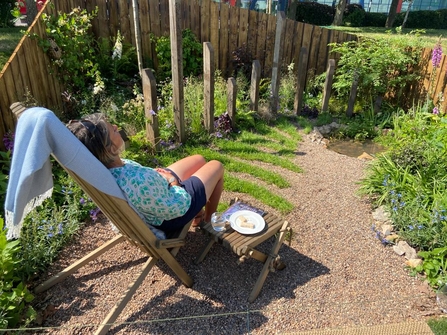Could you create an urban oasis?
Vicky Lincoln has been gardening since she was a child and has recently started her own business. She has an interest in wildlife, habitats and wellbeing and is keen to show how garden design can help wildlife and people.
Vicky's inspiring garden design, 'Urban Oasis', won the competition run by Warwickshire Wildlife Trust and Birmingham and Black Country Wildlife Trust at the Landscape Show in 2022, and the garden went on to be showcased at BBC Gardeners' World Live 2023 - winning a silver merit in the process!
Now it has found a new home at our Parkridge Centre in Solihull, where members of the public can visit and take inspiration from the wildlife-friendly features installed in the garden.

Vicky Lincoln's Urban Oasis garden at BBC Gardeners' World Live 2023
Inspiration for your home
The garden is designed to create a haven for wildlife from the ground up and uses recycled or reclaimed materials. It's dynamic and changes throughout the seasons, providing value for wildlife all year round.
The centre of the design is based on an unfurling fern, symbolising new beginnings, and features a quiet zone to give wildlife some undisturbed space. A rowan tree acts as a central feature, providing shade during summer months. Could you take inspiration from the garden in your own space?
Things you can do...
Make a log pile
The garden features a brushwood and log pile, creating important habitat for insects and pollinators. Pile up some old logs or tree cuttings in a shady spot to make a refuge for bugs and amphibians.
Add a wildlife pond
A small wildlife pond provides essential water and interest with aquatic plants and a small frog has already claimed the Parkridge pond as its own after just one day! A range of shrubs provide continual interest from inside and outside, and of course, essential winter shelter. Do you have space for a small pond? They don't need to be huge to have a big impact.
Add climbing plants
Vertical climbing plants on the fences such as honeysuckle and hydrangea provide food and shelter, and ‘hedgehog holes’ in the bottom of the fences ensure small mammals can travel through.
Make bee posts
Bee posts containing holes of different sizes have also been installed to allow safe nesting sites for solitary bees – these have already been taken advantage of and holes are beginning to be filled by bees, ready for the emergence of their young in the future. You can make your own using untreated wooden posts, or reclaimed wood, and carefully drilling some holes of different sizes. Aim for variety, from 2 - 10mm in diameter and at least 150mm deep, to give different types of bees some space.
View the full plant list of the garden here.
Come and see the garden!
Visitors can view the 5x5m garden on Mondays through to Fridays between the hours of 10 – 4pm and on Saturdays and Sundays between the hours of 10am and 5pm. We hope that visitors will be able to walk into the garden itself in the near future, but right now we're letting the plants and the grass settle in and you can view it from the front.
Entrance to the Parkridge Nature Reserve is free to members and non-members, although donations to Warwickshire Wildlife Trust are welcomed.
Help support ongoing maintenance of the garden
"This garden will be a welcome addition to Parkridge where it will provide inspiration for all our visitors to be able to make their patch more wildlife friendly. The use of nature friendly plants will provide food and shelter for an array of pollinators and other wildlife that call Parkridge home."Director of Nature Reserves





